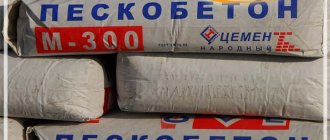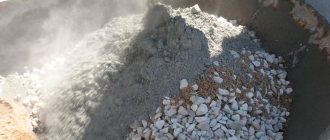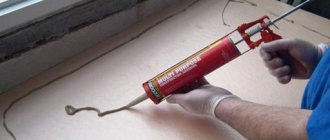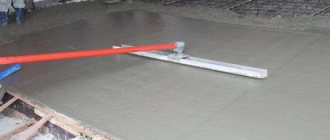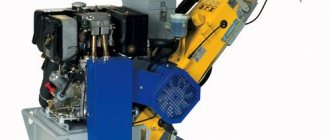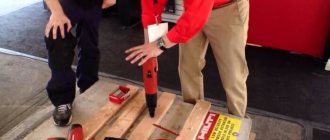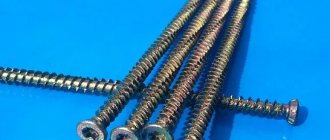The modern construction market offers a huge selection of different ready-made mixtures. The advantage of this product is its simplicity, versatility and relatively low price. You can increasingly hear about a composition called sand concrete. This product allows you to save time when mixing the solution, and at the same time the manufacturer guarantees high quality and efficiency. The finished composition is already packaged in bags in the correct proportion.
In some situations, a fraction of crushed stone is added to the finished mixture; this is done in order to increase the strength of the finished structure. However, everything depends on the brand and quality of the product and, of course, on the application. In some situations, the properties of sand concrete are sufficient and there is no need to add anything.
Composition and main characteristics of sand concrete
In fact, this is an ordinary dry batch of three main components, well dried and free of foreign matter:
- The fourth part of the mixture is the binding material - Portland cement grade 500;
- Plasticizing additives and fiber fiber;
- Three quarters - sand of fractions 0.5-0.8 mm, for screeds, gravel screenings of 2-4 mm, clay can be additionally added;
Sand concrete M300, intended for making concrete screeds and pouring floors, is characterized by the presence of large fractions of gravel, sand and grains, so the manufacturer usually labels the mixture or indicates its purpose on the packaging.
For example, the Leroy Merlin company simply writes the name on the packaging - floor screed, accordingly, the buyer himself must guess that the composition of such sand concrete contains small fractions of gravel, and it is not suitable for plaster. More serious manufacturers assign special indices to the M300 brand. For example, sand concrete M300 mku. The standard for structure and composition is initially aimed at repairing and pouring concrete floors.
Sand concrete M300, after a set of calculated strength characteristics, is capable of withstanding compressive contact pressure of up to 300 kg/cm2. The density of sand concrete m300 ranges from 1800 to 2200 kg/m3. In fact, this is enough to use dry sand concrete mixture to prepare a batch for pouring the foundation and most structural elements of low-rise construction.
For your information! For 1 m3 of a foundation made of lightweight M300 sand concrete, at least 1500-1700 kg of dry mixture will be required. For a concrete screed per 1m2 of screed, 1cm thick, the consumption of M300 sand concrete will be 17 kg per square.
Today, quite a lot of different grades of sand concrete are produced, given the universal nature of the mixture, sand concrete M300 is most widely used for finishing work - plastering walls or making screeds, for laying bricks and casting blocks. The technical characteristics of the hardened material M300 are given in the table.
Mixture consumption per 1m2 of brickwork
The consumption of mortar for brickwork depends on the type and thickness of the masonry, as well as on the brand of the mixture.
If the height and thickness of internal partitions and external walls built from brick are known, then it is not difficult to calculate the consumption of sand concrete required for laying walls. Based on the thickness and length of the wall, measured in meters, we determine the area of the horizontal seams. The standard joint thickness between bricks is 12 mm (0.012 m). Using these data, we determine the volume of the horizontal seam.
Figure 1. Brickwork “in brick”. This masonry is also called “spoon” masonry.
Certain difficulties may arise when calculating the volume occupied by vertical seams. As shown in Figure 1 (brick laying option), in some rows the bricks lie along the wall (this row is called a spoon row), and in the next row laid out the bricks will lie across the wall (this row is called a butt row). The width of such masonry is 250 mm. Figure 2 shows a “one and a half brick” masonry. The width of this masonry is 370 mm.
Of course, there is no need to count the number of vertical seams in a row. To take them into account, you can use known dimensions, for example, of ceramic bricks (250 × 120 × 65 mm), which are the same for both solid and hollow bricks. From Figure 2 it is easy to establish that when laying one and a half bricks per 6 bricks in a row, the area of vertical joints is equal to 250×65×6+120×65×2=113100 mm2=0.1113 m2. The area of the horizontal seam of the same 6 bricks will be 250 × 120 × 6 = 180000 mm = 0.18 m2. Therefore, to obtain the area of vertical seams, you need to multiply the known area of horizontal seams by the coefficient K = 0.1311: 0.18≈0.728.
Figure 2. “One and a half brick” masonry. The width of this type of masonry is 370 mm.
Let's calculate the consumption of the mixture for a wall 10 m long and 3.25 m high, laid out in one and a half bricks.
- the area of one horizontal seam is 0.37×10=3.7 m2;
- the area of all vertical joints along the length of the wall is 3.7×K≈2.8 m2;;
- the volume of seams is equal to (3.7 + 2.8) × 0.012 = 0.078 m3;
- the number of horizontal seams in the wall is 3250:65=50;
- the total volume of joints in the wall is 0.078×50 = 3.9 m3.
It was previously determined that 1 cubic meter of solution would require 1200 kg of sand concrete. Therefore, for a wall measuring 10×3.25 m2, laid with one and a half bricks, 1200×3.9 = 4680 kg of mixture, or 117 bags weighing 40 kg, will be required.
For hollow bricks, the consumption of the mixture will be approximately the same, since some part of the solution will fall into the voids.
calculation of sand concrete m300 for floor screed
PLASTERING WORKS.
We make walls and floors smooth!
We have been doing renovations in the construction market since 2004. We carry out the work according to the established construction standards SNIP. Most of our work process is mechanized. We use plastering stations of European quality Sertamaster 220/380 with a capacity of 75 m2 per 1 hour of operation, a built-in water pump, a 105 kg hopper, a 4 kW motor and a German D6/3 screw pair. GOST equipment 31606-2012. A more detailed description of the station can be found on the manufacturer’s website.
In finishing the premises we use only proven plaster solutions and mixtures. We purchase materials from trusted manufacturers, for example, primer and plaster mixtures from Knauf.
Contracts have been concluded for the supply of mixtures directly from the manufacturer at wholesale prices, which reduces the cost by up to 30%.
All work is regulated and checked during the work process.
For organizations, we will carry out plastering work in an apartment building, shopping center, office, store, cafe, restaurant, clinic, hospital, hotel, swimming pool and in any commercial building within the established time frame with a guarantee for the work. The quality of work can be viewed in our section on the website “Report on completed work”.
Latest completed orders for organizations:
— Repair work by Green-Master on Oktyabrskaya Street, 44 in Tula. — Renovation of the Tula Central Maternity Hospital on the street. Revolutions, 4, Tula. — Repair of the Arbitration Court of the Tula Region at Krasnoarmeysky Avenue, 5, Tula. — Plastering work at the Children's Infectious Diseases Hospital No. 2 on the street. Kutuzova, 8B, Tula. — House renovation in Tula in the village. Gorelki, Zarechensky district. — Plastering a house in Tula on Epifanskoe highway, Proletarsky district. — Renovation of a House in the Central District on Gogolevskaya Street.
For individuals, we will carry out plastering work in an apartment, house, country house, cottage, country house, garage within the established time frame with a guarantee for the work.
calculation of sand concrete m300 for floor screed
The quality of work can be viewed on our official website in the “Report on completed work” section.
Latest completed orders for 2017-2018. — Renovation of the 1st apartment in the Central district on Lenin Avenue in the city of Tula. — Plaster work in a one-room apartment in the Zarechensky district on Arsenalnaya street, Tula — Repair of a two-room apartment in the Zarechensky district, Plekhanovo village, Tula. — Plastering work in a two-room apartment – Tula, Sovetsky district, Frunze. — Renovation of a three-room apartment - Tula, Zarechensky district, M, Gorky. — Plastering a 3-room apartment – Tula, Proletarsky district, Kalinina street. — Plastering and turnkey renovation of a 4-room apartment — Tula, Proletarsky district, Kutuzova street. — Renovation of a five-room apartment — Tula, Central district, Friedrich street. — Plastering work in a 5-room apartment — Tula, Sovetsky district, Demonstration Street. — Renovation of 5 rooms in an apartment — Tula, Zarechensky district, st. Galkina.
You can also see in our reports how repairs are done using mechanized plaster. If requested, we send a list of completed projects to your contact email.
You can receive an estimate for the work by phone, using the feedback form, or write a message to the plastering and finishing specialist. Our official website Master Plasterer can be found on the Internet by searching for the calculation of sand concrete m300 for floor screed .
Screed drying time
Perhaps the most common question among ordinary people who for the first time decide to level the floors in an apartment on their own or fill a car deck at the dacha is how long it takes for a sand concrete screed to dry. If you mean how long it will take to load the resulting base (start repairing walls, install heated floors, just move on a new floor) - the answer is: 48 hours for operational load and 27-30 days for complete drying. If necessary, heated floors can be installed just a day after pouring.
You can buy sand concrete for floor screed ready-made or prepare the mixture yourself from the above components if you are confident in your knowledge in this regard. Experts, of course, choose industrial mixtures, preferring not to skimp on quality, but to use proven material. With the ready-mix M300, work can be done faster, more reliably and easier.
Plaster composition
Before deciding which one is best for plaster, you need to consider the general composition of the mixture. So, the composition of the plaster mortar includes:
- astringent component. Cement, gypsum or lime can be used as such material. If necessary, they can be combined, for example, use lime and gypsum;
- filler. The filler is stone chips, slag or sand. Sometimes special components are added that help create a decorative effect.
Each component has its own task. Binders perform many functions. They help speed up the rate of hardening of the mixture, impart plasticity, provide water resistance and protection from mechanical damage. Materials are selected depending on their purpose. If protection from moisture is needed, then preference is given to cement, and if plasticity is required, gypsum or lime is chosen.
A lot also depends on the choice of filler. This is why using the right sand is essential. The strength and sound insulation of the coating and the appearance of the plaster depend on the filler.
When you don't need to add crushed stone
Sand concrete has a filler in the form of large (2-5mm) and less often medium (05-2mm) fractions of sand. Therefore, for light loads, there is no need to introduce additional filler - crushed stone. For example:
- Additional crushed stone is poured into the sand concrete in order to minimize the possibility of deformation of the resulting structure. That is, if the expected load corresponds to the load for which the product is designed, nothing additional needs to be strengthened.
- If professionals work with the material and know what results need to be achieved, no additional interventions will be required, but if a beginner is working and this material is an experiment for him, pebbles can be added as a precaution. However, if you are not sure that the load matches the material, it is better to choose a different composition.
- When pouring strip foundations, it is enough to use a mixture with fine aggregate in the form of large fractions of sand, in which case no additional fractions are needed.
- For small jobs designed for “dacha” use, or when laying a screed on a small area, crushed stone is also not required.
- For repair work, in small areas, breaks and cracks, a clean mixture is excellent.
- Professional mixtures from reliable manufacturers are designed for large volumes of work and high loads, and do not require additional fillers. However, such mixtures are much higher than standard sand concrete mixtures.
Thus, we can conclude that crushed stone does not need to be added to the mixture if the load on the structure is not high and corresponds to the characteristics of sand concrete, but when working on large areas and under high loads, it is recommended to add an additional fraction, and for each individual type of mixture yours, limestone, gravel, granite.
Do you think it is more practical to use ready-made compounds or a standard cement-sand mixture?

